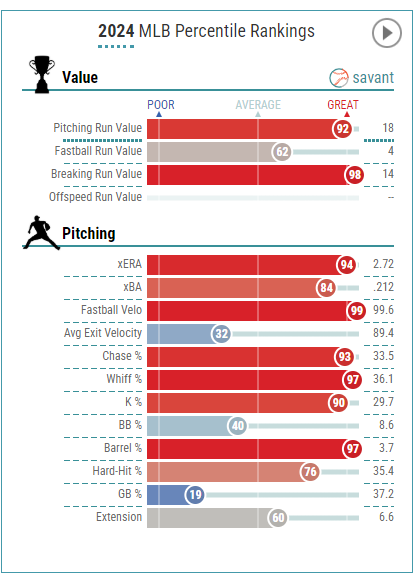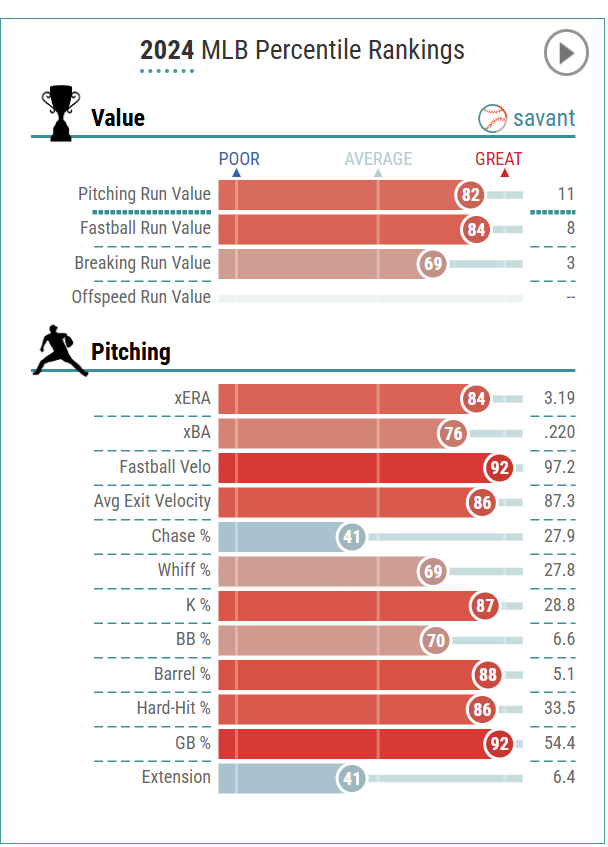Mike's fantasy baseball closers and saves strategies and sleepers for 2025 drafts. His fantasy baseball bullpen tips and later-round relief pitcher targets.
You will hear lots of discussion in the offseason on draft strategy for fantasy baseball. It seems it changes annually; for example, people will say things like "shortstop is deep this year" while suggesting "get your corner infielders early." The one position we struggle to define strategy for, year after year, is drafting closers and finding those ever-elusive saves.
How we attack this vital category varies widely by league. In both 10- and 12-team leagues, you can find waiver depth through your league's FAAB process. However, in 15-team leagues and deeply competitive leagues, saves will be much harder to find in plentiful supply. Thus, you may need to spend precious draft capital to be able to get saves.
One thing working to your advantage: you need fewer saves to be competitive and middle-of-the-pack in the category. In a 15-team league, you might only need 60-70 saves to be competitive in the category, depending on several factors. Let's take a deeper dive below for how to approach fantasy baseball closers and saves in 2025.
Be sure to check all of our fantasy baseball lineup tools and resources:- Fantasy baseball trade analyzer
- BvP matchups data (Batter vs. Pitcher)
- PvB matchups data (Pitcher vs. Batter)
- Who should I start? Fantasy baseball comparisons
- Daily MLB starting lineups
- Fantasy baseball closer depth charts
- Fantasy Baseball live scoreboard
- Fantasy baseball injury reports
Saves Distribution
According to research done by Jeff Zimmerman, about half of all the saves go to the initial closer. It was 52% in 2024, 58% in 2023, and 49% in 2021 and 2022. That means you have a 50/50 shot at that closer you draft, initially finishing the season with the job. The odds aren't great.
So what do we do as players mining for this fantasy gold? The chart below shows the spread of saves for the last three seasons. Of note: only eight closers earned more than 30 saves in 2024, while the other numbers remain steady. This makes hitting on that first closer tantamount to success.

Using Relief Pitcher "Stuff" as a Starting Point
I like to look at things like the chart below to see how a closer's pure "stuff" ranks up against other arms as an opening exercise in this activity. Below is Ryan Helsley. If you use Statcast at all, you likely know red is good! What I am looking for in a closer is elite skills: a K% above 28%, a K-BB rate of 20 or more, good whiff and chase percentages, and how hard they usually get hit.
In this case, Helsley checks all the boxes for elite production at the position. However, caveat emptor again: his injury history must give you pause, but if he is healthy, he is a top choice for the position. Helsley posted seven wins and 49 saves with a 2.04 ERA, a 1.10 WHIP, and 79 strikeouts in 66 innings. Elite production with good health.
Know Your League Format and Scoring System
The first and perhaps most obvious caveat is to know your league format and scoring system. You would be surprised how many people do not look at this or, worse yet, assume that they know the scoring system.
Several times a season, a friend will reach out to me and ask for an opinion on an addition to their team, and I will ask them first, what is the scoring system? League size? This is of vital importance as you build or add to your roster.
Are you in a pure 5x5 league? Are you in a league that counts saves + holds? Or one that uses holds as a category on its own? They do exist. A recent informal poll I conducted on X showed that 43% of leagues count only saves, 37% have a saves + holds category, and 20% have saves and holds as a separate category.
Saves and holds are growing in popularity as a category but have not fully caught on in the industry yet; some leagues are using saves and half-point holds, where closers still have a greater value than other high-leverage relievers. But this is a start to give those high-leverage pitchers who do not earn saves value in our leagues.
This informs how you build the roster. If the category is purely saves, you can try and roster the amount you think you will need in the draft. If you feel confident finding saves through the waiver wire or your FAAB process, just know that strategy can be fraught with peril. A strategy to use there would be to try and target the "next" guy up should a closer be struggling.
Let's use an example to illustrate this point: say Felix Bautista struggles with his command coming back from Tommy John surgery, and the Baltimore Orioles are mulling over a change. Andrew Kittredge might be the guy you targeted there a week earlier to garner those saves should he get opportunities.
The deeper the league, the harder it will be to find these replacement pitchers. Often they will be snatched up in the late rounds of snake drafts.
Stay ahead of your peers in this category by following the trials and tribulations of bullpens. There are several excellent resources on X to find this information. I am old and still love to read old-fashioned box scores. They tell you what is happening. Pay little attention to what managers say and only what they do.
Look at the Los Angeles Dodgers, for example. They have five guys who can easily get saves in that bullpen: Tanner Scott, Kirby Yates, Michael Kopech, Evan Phillips, and Blake Treinen. This could be a frustrating situation for fantasy players all season. Good luck with this one.
League context matters. Do you know your league mates? Do you have some inkling of how they value relief pitchers? Some league-mates might place a higher value on closers than you do, or vice versa. Do you have access to historical information on their draft predilections?
This is all helpful information as you plan your strategy. It is definitely worth looking at how your league-mates have drafted in the past to give you some background knowledge of how they value the category.
There is No Such Thing as a "Sure" Thing
Some fantasy players will value the idea of locking up a "sure" thing even though we know there is no such thing as a sure thing. Finding saves can be a volatile exercise as the year-to-year reliability is low. Even the top saves guys can lose their job due to ineffectiveness or injury.
If we look at 30 saves as our benchmark for an elite closer, there are only three relief pitchers who have had 90+ saves since 2022: Emmanuel Clase (133), Josh Hader (102), and Kenley Jansen (96). One of those guys is currently unemployed (Jansen).
My point is that we just don't know, despite our best efforts to get this knowledge. We all agree that Andres Munoz is the closer for Seattle. He's generally selected in the top 10 closers for our game, with an ADP at this writing of 89.
If your benchmark for saves in your top closer is 30, how many times has Munoz gotten to that number? You might guess two or three times. He's never reached it, and he's never even gotten to 25. His highest total was last year with 22 saves. Yet he's being drafted as an elite closer.
The issue is that he is a tremendous pitcher, but historically, he's sometimes used in the seventh or eighth inning to get key outs in the middle of the batting order, thus leaving the save for someone else. You're currently playing a sixth-round price for a guy who might not return that value to you.
Do you see the danger here? He's also a tantalizing talent and could easily get 35 saves if his usage changes a bit. With manager Dan Wilson in charge now, perhaps that changes. The fact remains: we just don't know despite our best efforts to know. See Munoz's career lines below: a fantastic arm but a little light on saves.
You need fewer saves to be competitive in the category in most leagues today. However, unless you punt the category, you are going to need to bank about 70 saves to finish in the middle of the pack. For example, when looking at NFBC Draft Champions leagues in 2023, you needed 74 saves to be in the 80th percentile, and 82 saves for the 90th percentile.
You're going to need some combination of relievers to get to this number. You might feel that getting two potential 30+ saves guys will get you there. Let's say you draft Raisel Iglesias as your top closer, and a few rounds later, you roster David Bednar. That could get you 60-70 saves right there.
In doing that, you should know that you may need to augment your team via your league's free-agent acquisition process. Or, you might take a later-round flyer on a middle reliever who could get save opportunities should a change happen on their team or young rookies who could explode up the depth chart quickly.
Here, I think of guys like Philadelphia's Orion Kerkering, who could get an opportunity if Jordan Romano is injured or ineffective. Colorado's Seth Halvorsen fits here, too, if he does not win the job outright in Spring Training. Below, you see Kerkering's Statcast page and why people are high on him in drafts.
Closers and Bullpen Draft Strategies
Try to draft one closer early who you'll project for 30+ saves. I would recommend in most leagues (especially 15-teamers) that you get a closer in the first seven or eight rounds. Then you can build around that with picks later in the draft, targeting lower-tier closers or high-leverage arms that could find themselves ascending to a closer role should injury or ineffectiveness plague their team's top option.
For example, let's say you roster Robert Suarez as a closer, but in doing so, it is best to be aware of some of the hazards. In that case, selecting Jeremiah Estrada later in the draft offers you an opportunity to get the Padres' saves without pause should something happen to Suarez, like a trade or ineffectiveness. If nothing else, Estrada gives you strikeouts, and the possible ratio helps.
Mining in the middle relief corps for breakout closer candidates will help you with ratios and strikeouts, at the very least. Being aware of the next guy up is crucial so that you can add them through your league's free agent acquisition process. Some pitchers who could fit here are Justin Slaten, Prelander Berroa, Robert Garcia, and Tony Santillan, among others.
I will share the strategy that I used last year in GLARF to give you an example of my process. GLARF is one of my toughest leagues, and as part of the Earth League, the competition is tough. I selected Emmanuel Clase in the fourth round to get that solid base of saves. I waited on my next closer until round 15, when I selected Mason Miller.
I followed that the next round with a terrible pick in Alex Lange. I grabbed Bryan Abreu late in the draft for ratio stabilization and strikeouts. Through some FAAB additions, I was able to finish tied for first in the category with 76 saves. It was a good season on that front, but my starting pitching betrayed me in the end.
The thing is, I may have overinvested in saves and could have potentially used that surplus elsewhere. My lesson: always be learning in this game. But..nabbing Clase and Miller looked pretty good, right?
You can also look for high-leverage guys on perceived playoff teams: Matt Strahm in Philadelphia, Griffin Jax in Minnesota, Cade Smith in Cleveland, and A.J. Puk in Arizona (if he is not closing). These will get some save opportunities, rack up 20+ holds, and help in other categories like strikeouts, ERA, and WHIP. Protect those precious ratios at all costs!
I would also strongly recommend looking at relief pitchers with a solid K-BB rate while looking at high strikeout rates. It's not rocket science, but the best pitchers to roster are those who miss the most bats.
All in all, there is not one strategy that is better than others. You have to cater your decision-making process to the league you are trying to win. Best of luck, and if you have questions, you can always hit me up @mdrc0508 on X. Happy drafting!
Download Our Free News & Alerts Mobile App
Like what you see? Download our updated fantasy baseball app for iPhone and Android with 24x7 player news, injury alerts, sleepers, prospects & more. All free!

 RADIO
RADIO



























